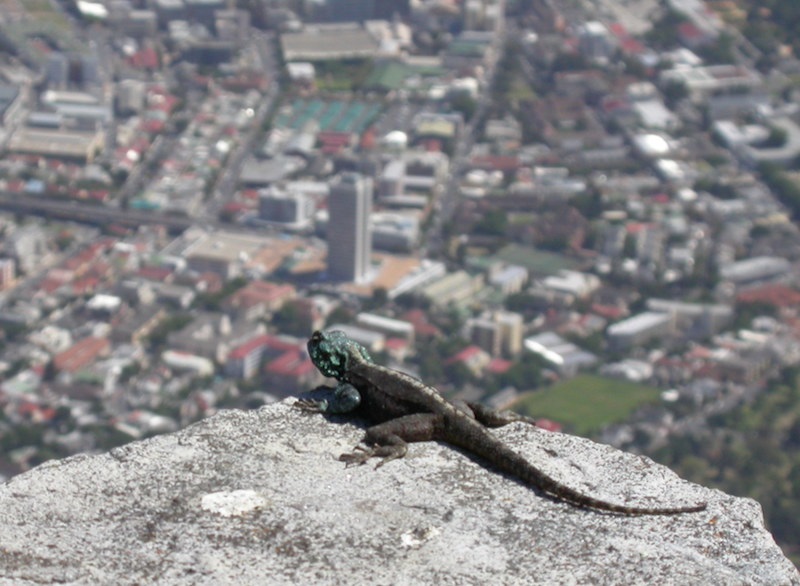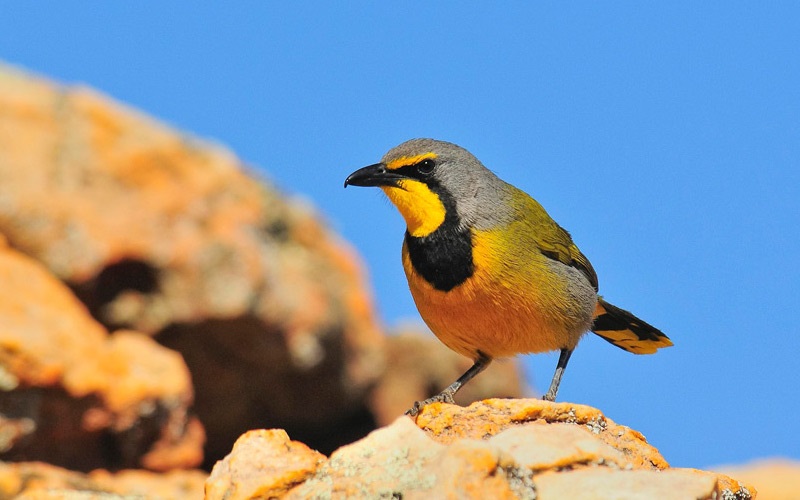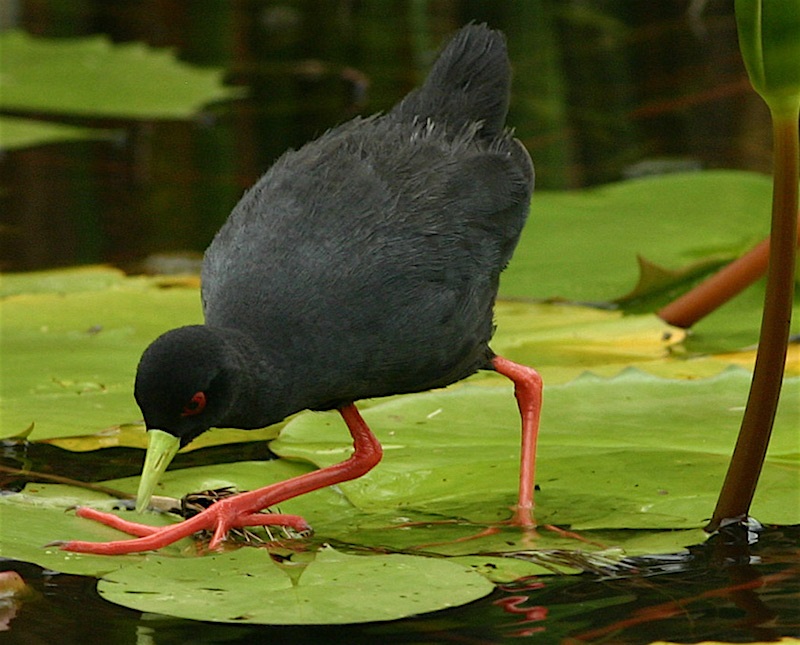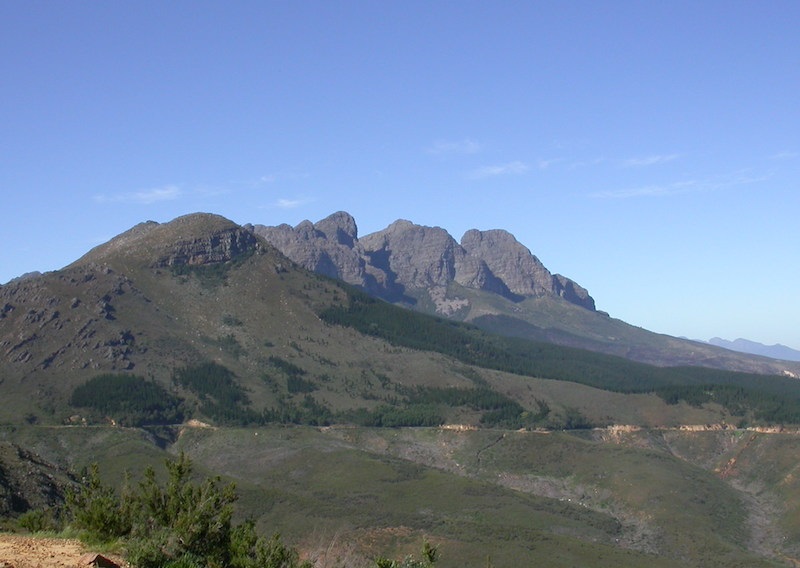South Africa is one of the best value birding destinations on the entire continent. The outstanding infrastructure, great accommodation, excellent food, wonderful South African hospitality, spectacular and varied scenery, and the presence of Africa’s big and small mammals makes it one of the most pleasant countries in the world to bird in. Typically, the birds are easy to find, and well over 500 species can be seen during a 3-week trip. But South Africa is not only one of the best countries to start one’s African birding in – it is also boasts more endemic species than any other country on this vast continent, making it an essential country for any world birder.
Access
The vast majority of international birders fly into South Africa. The country has three international airports – Johannesburg, Cape Town and Durban. The country is served with regular daily flights by most major airlines. The important domestic airports at Port Elizabeth, East London, George, Bloemfontein, Kimberley and Upington are all serviced by regular internal flights. It is also possible to reach the country via overland trips through Africa or via one of the many cruises that visit the country’s major ports – Cape Town, Port Elizabeth, East London and Durban. For UK travellers the time zone is GMT + 2.

Major Topographical Features
Simply put South Africa is comprised of a high lying plateau (known locally as the Highveld) in the eastern interior largely 1,500m or more above sea level. This falls away in the west and north into a bowl-shaped feature known as the Kalahari Basin. These two features are rimmed by a mountainous escarpment – known as the Great Escarpment or simply the Escarpment – which varies in altitude from around 800m in the west to more than 3,000m in the Drakensberg range in the east. Finally there is a narrow coastal plain 50 to 200km wide and mostly below 500m in altitude.
Major Habitat Regions
Bird-wise South Africa can be divided into seven major natural regions: Grassveld – almost treeless grassland; Fynbos (pronounced fain-bos) – a sort of Macchia or chaparral; Karoo – an arid to very arid semi-desert; Afromontane Forest – more or less evergreen with a closed canopy; Bushveld – a fairly arid to arid open to closed woodland often referred to in South Africa as Savannah; the East Coast Littoral – a moist tropical to sub-tropical mosaic of forest, coastal thicket and grassland; and Pelagic – open sea up to 200km off-shore. Each of these regions have their own suite of birds and other flora and fauna and the first four hold many endemic bird species.
Mammals
South Africa is, of course, a wonderful for large and small mammals. although, outside of Kruger the larger mammals tend to be in large, fenced-in reserves rather than part of the general scene. Many animals sich as Rhino have been re-introduced to boulster wild population and create popular game parks. Unfortunately some still operate as hunting arenas for the bloodthirsty rich. But uncultivated areas are sill home to a great many herbivores and small carnivores as well as the coastal areas rich in marine mammals and other fauna.
Flora
South Africa is where a great many of our familiar garden plants came from and vast areas of flowers like osteospernums carpet the Karoo and other places during spring. Enthusiastic botanists and gardeners will find a great deal to delight as well birdwatchers who will be drawn to flowering plants to see the nectar feeders like sugarbirds, sunbirds and others.
Pelagics
Pelagic trips are run out of various harbours in South Africa but, generally, Cape Town offers, by far, the best sea watching in South Africa. In fact, is considered to be some of the best anywhere in the world. The cold Benguela Current brings highly nutrient-rich waters up from the south, and the strong winds (predominately from the south-east) create an up welling that brings all the nutrients to the surface. This, in turn, sustains the phytoplankton that forms the basis of the marine food chain. Pelagic fisheries thrive in the area, and discards from the trawlers provide a constant food source for pelagic birds. There are around 85 species that have been recorded on South African pelagic trips including albatrosses, petrels, shearwaters, skuas and a whole host of other exciting birds. Day trips can produce in excess of 30 species with, particularly winter trips, providing the spectacle of some 30,000 individual birds. Added to this, there are a number of whale and dolphin species that are encountered as well as some other interesting marine wildlife.
Pelagic trips are spectacular to say the least and will provide one with many cherished memories. If you are in South Africa, it should become a priority on your itinerary and should not be missed. Cetaceans of many species are also to be expected with Cape Fur Seals and other marine mammals. Southern Wright at particular times of the year.

The Afromontane Forests – Approx. 1,000 km²
South African Afromontane forests are highly fragmented and largely scattered along the southern and eastern slopes of the Great Escarpment. With the exception of the fairly extensive forests around the coastal towns of George and Knysna and to the south of Port Elizabeth, all are located more than 40 km inland. The southern forests are best accessed from Cape Town, Durban, George or Port Elizabeth. Johannesburg is the closest airport to the northern forests of Mpumalanga and the Northern Province. As is typical of mountainous areas everywhere the weather is rarely predictable except that it will be cold in winter. Summers are generally mild and evenings can be cool. Rain and mist can be expected throughout the year.
Some 120 species occur regularly in the Afromontane Forests. Nine of South Africa`s endemic species (two are endemic to the forests) and a further 15 species (eight of them are nearly endemic to these forests) endemic to southern Africa are found here. Birding hotspots include Grootvadersbos and the George-Knysna area in the Western Cape Province, Hogsback and Weza-Ingele forests in the Eastern Cape, Xumeni and Ntumeni in KwaZulu-Natal, the Barberton-Graskop-Blyde River Canyon area in Mpumalanga and Woodbush/Magoebaskloof in the Northern Province.
The Bushveld – Area 385,799 km²
The Bushveld can basically be divided into two areas – the arid Bushveld of the Kalahari in the west and the moist Bushveld in the east. It shares the Kalahari basin with the Karoo in the west and the north, but also extends into the lower lying area between the Great Escarpment and the East Coast Littoral in the east. The arid west is best accessed from Kimberley and Upington while the east and north is best accessed from Johannesburg. South Africa`s two giant conservation areas – The Kruger National Park and the Kgalagadi Transfrontier Park – as well as the Pilanesberg and Hluhluwe-Umfolozi Game Reserves, are situated in the Bushveld and most of the country`s remaining large mammal population is found here. For the most part summers are warm to hot and winters mild to cool. What rainfall there is falls during summer. Malaria can be a problem throughout the year in the moister east, but particularly in summer so anti-malarials are needed.
Almost 550 species of birds occur regularly in the Bushveld. None of these are endemic to the South African Bushveld, but no fewer than 86 of the species endemic or nearly endemic to southern Africa as a whole can be found here. Birding hotspots are many in such a diverse area, but some of the best known ones include the Hluhluwe-Umfolozi Game Reserves in KwaZulu-Natal, the Kgalagadi Transfrontier National Park in the Northern Cape and Kruger National Park in Mpumalanga and Northern Province. Other less well-known spots include Nylsvley and Langjan Nature Reserves in Northern Province, the area north of Pretoria in Gauteng Province, the Kimberley area and Witsand Nature Reserve in the Northern Cape and Loskop Dam Nature Reserve in Mpumalanga.

The East Coast Littoral
This area is made up of a mosaic of sub-tropical to tropical grassland, woodland and forest and not surprisingly has a high diversity of species. As the name implies it is a narrow strip stretching up the east coast of South Africa from north of Port Elizabeth to the South African-Mozambique border. The area is best accessed from Durban or Port Elizabeth. The climate is generally humid with hot, wet summers and warm winters. Malaria can be a problem in the areas north of the towns of Eshowe and Mtunzini and anti-malarial drugs and other precautions are recommended when visiting these areas.
Nearly 430 regularly occurring species can be found in this narrow coastal strip. While no species are endemic to the South African portion itself, five species – Pink-throated Twinspot, Neergard`s Sunbird, Rudd`s Apalis, Lemon-breasted Canary and Woodwards Batis all have a very localised distribution in northern KwaZulu-Natal and southern Mozambique, occurring only marginally outside this area. Overall, 38 species found here are endemic or nearly so to southern Africa. It is difficult to single out any particular birding hotspot – virtually the entire area is a hotspot! Mkuzi and Ndumo Game Reserves, the Greater St Lucia Wetland area (a World Heritage site); Mtunzini village, Ongoye, Ntumeni and Dhlinza Forests near Eshowe and Oribi Gorge near Port Shepstone are but a few that spring to mind.

The Fynbos – Area 59,282 km²
The Fynbos occurs on the coastal plain and southern mountain slopes in the southernmost part of the African continent. It stretches from north of St Helena Bay in the west to around Port Elizabeth in the east. The vegetation comprises mostly a macchia type of scrub and it is renowned for its botanical variety. It is best accessed from Cape Town, George or Port Elizabeth. Typically the climate consists of mild to warm, dry summers (wetter in the east) and cool, wet winters.
Some 270 species of birds occur regularly in the Fynbos, with a respectable suite of rather localised endemics. Birding hotspots include the Cape Peninsula, the West Coast National Park, the Berg River Estuary and De Hoop Provincial Nature Reserve.
The Grassveld – Area 280,047 km²
South Africa’s Grassveld is concentrated in the high lying interior plateau and is best accessed from Johannesburg or Durban. East London, Bloemfontein and Kimberley are other possibilities, particularly for the more arid western areas. The climate is typically mild to warm, wet summers and cold, frosty, dry winters with snow sometimes in the higher lying areas.
More than 400 species occur regularly in the Grassveld, including a good number of South Africa’s endemics. In common with grasslands throughout the world South Africa’s grasslands are under huge pressure from human development programmes. As much as 80% of South Africa’s grasslands have been put to the plough, planted to alien trees, covered by urban sprawl or swallowed up by huge open-cast pits. These threats are reflected in its bird life.
Birding hotspots in the Grassveld include Wakkerstroom and Sani Pass (between South Africa and Lesotho) in the moist eastern area and Barberspan and the Bloemhof area in the arid west.
The Karoo – Area 369,946 km²
The Karoo stretches eastward from South Africa`s west coast, north of St Helena Bay across the southern portion of the Kalahari basin. The most arid parts are found in the north-west along the Namibian border, gradually becoming less arid to the east and south. It is best accessed from Cape Town, George, Port Elizabeth, East London, Kimberley or Upington. Generally summers are hot and dry with winters being cold and dry. What rain there is generally falls in spring and autumn and this is the best time for birding in this fascinating part of the country.
More than 300 species occur regularly in the Karoo, and the number of endemics here is staggering.
Kruger National Park
The world-famous Kruger National Park is situated in the north-eastern corner of South Africa.
It is predominantly a semi-arid summer rainfall area with rainfall varying from 350 mm to 800 mm. Most of Kruger is between 250 and 550 metres above sea level, and the interaction of the rainfall and altitude with soil types provides a wide a range of habitats. It covers an area of 19,485 square kilometres (7,523 sq mi) in the provinces of Limpopo and Mpumalanga in northeastern South Africa, and extends 360 kilometres (220 mi) from north to south and 65 kilometres (40 mi) from east to west. The administrative headquarters are in Skukuza. Areas of the park were first protected by the government of the South African Republic in 1898, and it became South Africa’s first national park in 1926.
To the west and south of the Kruger National Park are the two South African provinces of Limpopo and Mpumalanga. In the north is Zimbabwe, and to the east is Mozambique. It is now part of the Great Limpopo Transfrontier Park, a peace park that links Kruger National Park with the Gonarezhou National Park in Zimbabwe, and with the Limpopo National Park in Mozambique.
Plants life in the park consists of four main areas:
Thorn trees and red bush-willow veld – This area lies between the western boundary and roughly the centre of the park south of the Olifants River. Combretums, such as the red bush-willow (Combretum apiculatum), and Acacia species predominate while there are a great number of marula trees (Sclerocarya caffra). The Acacias are dominant along the rivers and streams, the very dense Nwatimhiri bush along the Sabie River between Skukuza and Lower Sabie being a very good example.
Knob-thorn and marula veld – South of the Olifants River in the eastern half of the park, this area provides the most important grazing-land. Species such as red grass (Themeda triandra) and buffalo grass (Panicum maximum) predominate while the knob-thorn (Acacia nigrescens), leadwood (Combretum imberbe) and marula (Sclerocarya caffra) are the main tree species.
Red bush-willow and mopane veld – This area lies in the western half of the park, north of the Olifants River. The two most prominent species here are the red bush-willow (Combretum apiculatum) and the mopane tree (Colophospermum mopane).
Shrub mopane veld – Shrub mopane covers almost the entire north-eastern part of the park.
There are a number of smaller areas in the park which carry distinctive vegetation such as Pretoriuskop where the sickle bush and the silver cluster-leaf (Terminalia sericea) are prominent. The sandveld communities near Punda Maria are equally definitive, with a wide variety of unique species.
As one of the largest reserves in Africa it boasts over 500 bird species alone. The rest camps, rivers and drainage lines provide for some of the best birding in Kruger in terms of diversity. A morning of intense birding in of these areas in summer may well produce over 150 species. The area around Skukuza restcamp in the south of Kruger is particularly good for birding and is one the best spots for the African Finfoot. Additionally, it hosts a number endemic and near endemics such as Whitethroated Robin and Natal Francolin amongst a diversity of other attractive bushveld and riverine species.
The western half of Kruger is generally more wooded whereas the eastern half of Kruger is generally more open grassland and it is here where species such as Ostrich, Kori Bustard, Lesser Black-winged Plover and Red-crested Korhaan are more commonly found. Raptors in Kruger are plentiful, and it is a great place to view a large diversity of large and small raptors such as the colourful Bateleur or aerial acrobat.
Five species of vulture are regularly recorded in Kruger and it is not all that uncommon to have all 5 species feeding at one kill. All the Big Five game animals are found at Kruger National Park, which has more species of large mammals than any other African game reserve (at 147 species). There are webcams set up to observe the wildlife. Kruger supports packs of the endangered African wild dog, of which there are thought to be only about 400 in the whole of South Africa. This brings us to what Kruger is famous for – its great diversity of carnivores, large mammals and other wildlife.
There are also 114 species of reptile and thirty-three species of amphibians.
Birders are amazed by the reserve, and the opportunity it offers to record a vast number of bird species, whilst at the same time viewing Africa’s charismatic wildlife in a 20,000 square kilometre expanse of wilderness.
Text Source: Fatbirder
Map Source: Googlemaps™
Photo Source: © Birding Ecotours
